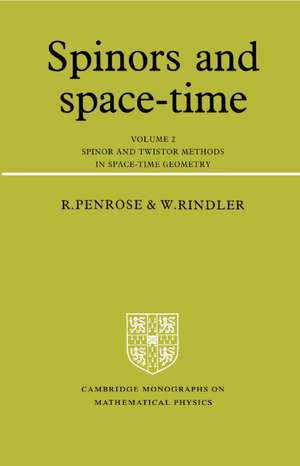Spinors and Space-Time: Volume 2, Spinor and Twistor Methods in Space-Time Geometry: Cambridge Monographs on Mathematical Physics
Autor Roger Penrose, Wolfgang Rindleren Limba Engleză Paperback – 6 apr 1988
Din seria Cambridge Monographs on Mathematical Physics
-
 Preț: 327.44 lei
Preț: 327.44 lei -
 Preț: 215.55 lei
Preț: 215.55 lei -
 Preț: 398.64 lei
Preț: 398.64 lei -
 Preț: 232.44 lei
Preț: 232.44 lei -
 Preț: 215.60 lei
Preț: 215.60 lei -
 Preț: 309.49 lei
Preț: 309.49 lei -
 Preț: 259.40 lei
Preț: 259.40 lei - 14%
 Preț: 981.98 lei
Preț: 981.98 lei -
 Preț: 389.42 lei
Preț: 389.42 lei - 8%
 Preț: 429.05 lei
Preț: 429.05 lei - 14%
 Preț: 882.44 lei
Preț: 882.44 lei -
 Preț: 351.96 lei
Preț: 351.96 lei - 11%
 Preț: 422.27 lei
Preț: 422.27 lei -
 Preț: 372.97 lei
Preț: 372.97 lei -
 Preț: 368.17 lei
Preț: 368.17 lei - 11%
 Preț: 506.16 lei
Preț: 506.16 lei - 19%
 Preț: 437.97 lei
Preț: 437.97 lei -
 Preț: 374.88 lei
Preț: 374.88 lei -
 Preț: 365.09 lei
Preț: 365.09 lei - 11%
 Preț: 419.02 lei
Preț: 419.02 lei -
 Preț: 444.29 lei
Preț: 444.29 lei - 11%
 Preț: 682.44 lei
Preț: 682.44 lei -
 Preț: 421.40 lei
Preț: 421.40 lei -
 Preț: 321.05 lei
Preț: 321.05 lei -
 Preț: 385.63 lei
Preț: 385.63 lei - 11%
 Preț: 464.44 lei
Preț: 464.44 lei - 8%
 Preț: 488.25 lei
Preț: 488.25 lei - 11%
 Preț: 590.73 lei
Preț: 590.73 lei - 11%
 Preț: 518.55 lei
Preț: 518.55 lei - 11%
 Preț: 448.37 lei
Preț: 448.37 lei - 11%
 Preț: 572.25 lei
Preț: 572.25 lei -
 Preț: 414.74 lei
Preț: 414.74 lei - 11%
 Preț: 479.51 lei
Preț: 479.51 lei - 11%
 Preț: 478.18 lei
Preț: 478.18 lei - 23%
 Preț: 1343.82 lei
Preț: 1343.82 lei - 14%
 Preț: 897.75 lei
Preț: 897.75 lei - 11%
 Preț: 577.80 lei
Preț: 577.80 lei - 11%
 Preț: 479.52 lei
Preț: 479.52 lei -
 Preț: 460.39 lei
Preț: 460.39 lei - 14%
 Preț: 831.25 lei
Preț: 831.25 lei
Preț: 619.56 lei
Preț vechi: 696.14 lei
-11% Nou
Puncte Express: 929
Preț estimativ în valută:
118.57€ • 128.75$ • 99.60£
118.57€ • 128.75$ • 99.60£
Carte tipărită la comandă
Livrare economică 22 aprilie-06 mai
Preluare comenzi: 021 569.72.76
Specificații
ISBN-13: 9780521347860
ISBN-10: 0521347866
Pagini: 512
Ilustrații: illustrations
Dimensiuni: 152 x 228 x 32 mm
Greutate: 0.76 kg
Ediția:Revised
Editura: Cambridge University Press
Colecția Cambridge University Press
Seria Cambridge Monographs on Mathematical Physics
Locul publicării:Cambridge, United Kingdom
ISBN-10: 0521347866
Pagini: 512
Ilustrații: illustrations
Dimensiuni: 152 x 228 x 32 mm
Greutate: 0.76 kg
Ediția:Revised
Editura: Cambridge University Press
Colecția Cambridge University Press
Seria Cambridge Monographs on Mathematical Physics
Locul publicării:Cambridge, United Kingdom
Cuprins
Preface; Summary of volume 1; 6. Twistors; 7. Null congruences; 8. Classification of curvature tensors; 9. Conformal infinity; Appendix; References; Subject and author index; Index of symbols.
Recenzii
"Topics covered include massless fields, the geometry of light rays, and the conformal structure of infinity. Twistorial applications abound and are presented in great detail. The approach here is to show how problems with the standard physical framework may be solved using new twistorial techniques." American Mathematics Monthly
